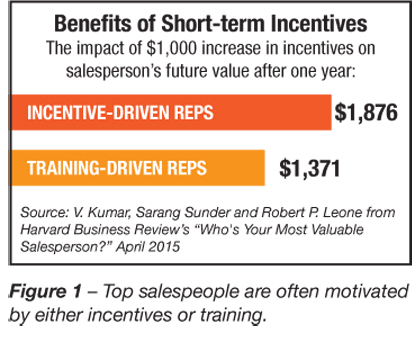|
Calculating the ROI of a Salesperson Managing a sales team is a task that can be fraught with stress. Sales managers are responsible for the success of the team both collectively and individually. Everyone must perform at an optimal level. If they are not, then they must be replaced as soon as possible. How can a sales manager effectively measure the return on investment for each salesperson on a team? The answer is a mix of quantitative and qualitative factors. Calculating the ROI of a Salesperson Put most simply, calculating ROI involves measuring the gains minus the cost, and dividing the resulting number by the cost, and multiplying by 100 to get a percentage, such that: (Gain on investment - Cost of Investment)/ Revenue Accelerator (www.therevenueaccelerator. com) and Sales Benchmark Index (www. salesbenchmarkindex.com) both provide some templates that incorporate this formula, bolstered with additional inputs of relevance, but you’ll have the best sense of whether or not the salespeople on your team are working out by developing your own ROI formula. The factors used to judge a sales team are different for every organization, or even within your own organization! The Salesperson’s Tenure When calculating the ROI of any employee, an initial consideration is breaking even on the costs to hire, bring on board and train them. According to Investopedia (www.investopedia. com), even a minimum wage employee can cost a company up to $3,500 in turnover costs. Additionally, companies spend an average of $1,200 on training annually, per employee (much of that on the front-end of a new employee’s tenure). There are also costs associated with workplace integration, though many are hard to measure exactly. Sales Copilot (www.salescopilot.com) found that for small to medium enterprises, the average tenure of a salesperson is 2.5 years. Factoring in ROI considerations, including ramp-up time and your company’s overall sales cycle (there are more on those two below), this relatively short period can impede a company’s growth. According to Sales Copilot, a better number to aim for is 4+ years. Put most simply, reduce churn to increase ROI! Your Sales Cycle A sales cycle can also differ from one sales organization to another. An agency selling marketing services to a small company might have a fairly short sales cycle—a matter of weeks or months at most. On the other hand, an enterprise software solution involving hundreds of thousands of dollars per year and multiple decision makers can take a year or more to close, on average. Before judging a salesperson on their effectiveness with closing new deals, you must first define the average sales cycle for your organization. Geckoboard (www.geckoboard.com) offers a useful two-step formula for calculating your organization’s sales cycle: Step 1: Add the number of days from first contact to customer conversion for all deals and that equals the total number of days for all sales combined. Step 2: Take the total number of days for all sales combined from Step 1, divide it by the number of deals and that equals the number of days for the average sales cycle. As this data refers to your team as a whole, you might consider removing outliers like super high or low performers for a more representative number. The Ramp-Up Period Similar to factoring in the effect of the sales cycle, you also have to account for the time it takes to get new sales representatives up to speed. This is less important with seasoned salespeople who don’t need to learn sales 101. However, even in these situations, they still need time to learn about your company and build their book of business in relation to your products and services. A totally green salesperson, however, will need more time for training and shadowing to get up to speed before you can let them run wild. LevelEleven (www.leveleleven.com) offers three formulas for measuring sales ramp-up: 1. The Sales Cycle Method: Ramp-up = Length of Sales Cycle + 90 Days. This formula is simple and straightforward, based on your company’s sales cycle. According to the author, 90 days may be somewhat arbitrary and should be adjusted based on your own time allotted to training. 2. Quota Attainment: Ramp-up = Length of Time to Reach 100 Percent Quota. Also fairly simple and straightforward—this method is considered to be the industry standard. Unfortunately, it’s rife with potential flaws and can be hard to track if measurement is not automated with your CRM. 3. Training and Tenure: Ramp-up = Training Period + Length of Sales Cycle + Experience. This formula has the most potential to be accurate as it accounts for several different areas of importance. That said, it may also be the hardest to definitively assign numbers to. No matter what formula you use to measure your sales ramp-up period—whether you use these or a formula of your own design—it’s important to experiment and refine it over time. Contribution Margin Accounting Tools (www.accountingtools.com) defines contribution margin as: “the revenue from a sale transaction, less all variable costs associated with that sale.” A salesperson’s salary, benefits and training costs are certainly worth consideration in terms of the ROI that results. Sales Copilot suggests that a contribution margin between 3 and 5 to 1 is ideal. Qualitative Factors In addition to some of the quantitative factors affecting the ROI of a salesperson as listed above, there are some additional points of consideration that are a bit harder to measure, but are important, nonetheless. ■ A salesperson’s impact on the team. Whether they’re outright negative or a constant distraction, one person can definitely spoil an entire team’s effectiveness. Address issues as soon as they surface and if an individual continues to negatively impact the effectiveness of the entire team, they need to be reassigned to another department or let go. ■ A salesperson’s satisfaction with their job. Part of this is a function of compensation. Do you provide enough opportunity for a sales representative to earn as much as they’re hungry for? If that’s not the issue, maybe they’re not meant to be a salesperson. Regardless, an unsatisfied salesperson will have trouble performing optimally—and providing an ROI. Ideas to Improve the ROI of a Salesperson If a salesperson’s ROI doesn’t seem to be there, it’s time to take action. But instead of defaulting to giving them the boot, consider ideas for potentially improving performance (and ROI, as a result): ■ Hire better cultural fits. Because a sales team’s weakest links are each individual member, it’s important to ensure a cultural fit during the hiring process. ■ Offer incentives to boost sales. Harvard Business Review (hbr.org) separates top sales representatives into two groups: those that are driven by incentives and those that are driven by training. Periodically offering incentives can be a great way to boost ROI—so long as they are aligned with your company’s growth plans. The figure below shows how that looks in terms of a rep’s future value to a company.
■ Offer enough money for them to be happy. In an article in Time magazine (www.time.com) Princeton University found that $75,000 is the optimal annual salary for happiness. Although the typical salesperson’s base may not start at this point, it should feel like an achievable number based on the average earnings of your team with regards to commission. When people are happy, they’re more likely to perform at their peak. ■ Provide additional training and coaching opportunities to those that want them. Sometimes a lack of ROI refers to a lack of skill. But many skills can be learned, so offer additional opportunities for improvement in order to help new or struggling sales people turn things around. Final Thoughts Determining the ROI of a salesperson isn’t quite as easy as plugging numbers into a formula. There are some things you can do to provide easily digestible numbers to your higher ups, while other ROI determinations will have to be done an a rep-by-rep basis, factoring in qualitative factors. If the ROI just isn’t there, you’ll have to make adjustments accordingly. But in some cases, it’s worth trying to fix the situation before giving up on a salesperson entirely. About the Author Sales Awakening is a sales consulting, coaching and training company that is designed to help businesses — whether they are a growing startup or established enterprise — achieve extraordinary results with its array of sales and marketing concepts. More information is available at www.salesawakening.com or by emailing [email protected] or calling (419) 930-4242. |

